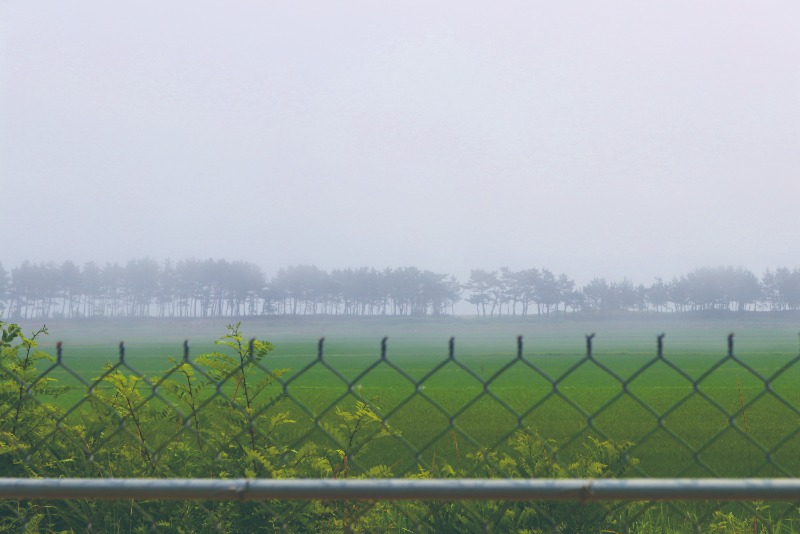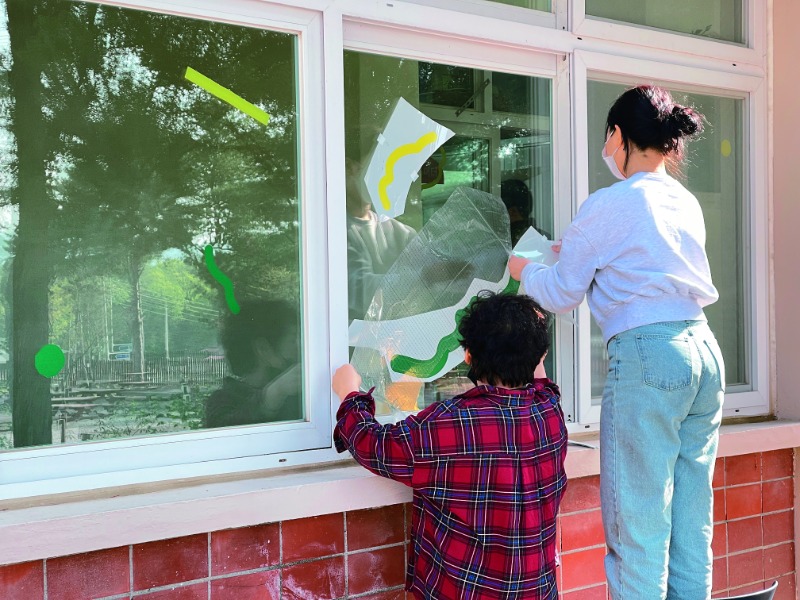The demilitarized zone (DMZ) that bisects the Korean peninsula is a rich repository of stories. They are told by people who have lived in and around the DMZ for many decades, preserving a unique culture and distinctive memories. Park Han-sol has recorded their lives in “about dmz,” a magazine that unveils unknown aspects of the national division.
Life does not always go according to plan. Park Han-sol is an architect and doctor of engineering. She studied landscape architecture as well as architecture, but going a step beyond these fields, she is now working to discover immaterial stories to fill material space. All About is a content company that she launched to chronicle recollections of unheard-of things and places in Korea. The company’s first project was an independent magazine titled “about dmz.” It’s not something she had imagined herself doing, but she says it brings her immense happiness.

Park Han-sol, the president of All About, a content company, preserves the unique culture and memories of inhabitants inside the DMZ through the “about dmz” indie magazine.
PEOPLE LIVE THERE
“If you google ‘DMZ,’ you’ll find images of natural scenery as well as military images focusing on the truce village of Panmunjom,” Park observes. “But people are living there, making their own memories.” Although All About also explores other locations, the commitment to “about dmz” is permanent. After all, it is the company’s cornerstone.
The DMZ is a remnant of the Korean War, which erupted on June 25, 1950. It refers to a strip of no-man’s-land created by the UN Command, the North Korean People’s Army, and the Chinese People’s Volunteer Army, when they signed an armistice agreement on July 27, 1953. Spanning 248 km across the Korean peninsula, the DMZ itself is divided by the so-called Military Demarcation Line. On either side is a 2 km wide band controlled by South Korea and North Korea, respectively. Fifteen border towns occupy the southern side of the DMZ, and stories about three of them have been published in book form. The first book, “about dmz, Vol. 1: Active Cheorwon,” sheds new light on the border town in Gangwon Province. Cheorwon was merely regarded as a cold and quiet place, but it contained a trove of stories passed down through generations. This book vividly captured the town’s sights and sounds, based on these recollections. The second book, “about dmz, Vol. 2: Relieve Paju,” introduces Paju in Gyeonggi Province both as a border town and a holiday destination. It contains stories about a picturesque marsh where flocks of migratory birds stop to rest; places that attract vacationing city dwellers; and Jangpa-ri, which bears the scars left by a U.S. military base once stationed there. The use of “Relieve” in the subtitle has a double connotation – “freed from a burden” and “bringing relief.” “about dmz, Vol. 3: Revive Goseong” just came out in August. The stories about Goseong, a border town in Gangwon Province, differ from those about border towns in Gyeonggi Province. The DMZ still remains a “mystery” to Park, despite her many visits over a long period of time to do research and collect stories. The more often she visits, the more intrigued she becomes.
“The houses in Minbuk Village in Cheorwon, near the DMZ, are called House No. 1, House No. 2, House No. 3, and so on. The village was built in an area north of the Civilian Control Line to cultivate fallow land. The residents use house numbers instead of regular addresses for the sake of convenience as they have long been under military authorities’ control. The village also has an armory, and army officers used to conduct roll calls every day to make sure that everybody was accounted for and even carry out military training for local residents – all a legacy of the past. A unique culture has been built there with memories of the times after the Korean War piled up in layers.”
In Minbuk Village, there are traces of the abandoned Geumgangsan Line, the electric rail link between Cheorwon and Naegeumgang, the inner part of Mt. Geumgang, currently in North Korea. Built in the 1920s, during the Japanese occupation (1910-1945), the Geumgangsan Line was Korea’s first tourist railway. Remains of buildings erected during the Japanese occupation still stand nearby. Had it not been for the Korean War and national division, the railway would likely still be in service.
“This area isn’t as vast as described by mass media. In fact, it looks desolate. It’s because border guards of the South and the North often cut the grass and trees or burn them to ensure clear visibility. The most beautiful scenery I’ve ever seen there was of a f lock of red-crowned cranes [durumi]. The birds arrive in Minbuk Village every winter thanks to the benevolence of villagers who do paddy rice farming. They leave grains of rice on the paddies for the birds, instead of binding threshed rice stalks into sheaves to sell after the harvest. In a sense, the villagers and the birds are living together as partners,” Park says.
All About is helping the villagers sell their rice in the market under the brand name “Durumi,” as part of a marketing campaign for their specialty products.
REVIVED MEMORIES
Park realized she knew virtually nothing about the DMZ in 2016, when she was studying at Seoul National University’s Graduate School of Environmental Studies. At the time, her thesis advisor was involved in the “Real DMZ Project,” an urban culture and contemporary art project. When she accompanied one of her professors to Minbuk Village, she marveled at the surrounding landscape. Born and raised in Seoul, she had never visited a rural area, and growing up with no brothers, she had no firsthand experience of a military culture or environment. She felt sorry that nobody had told her about the post-war years, and thinks she would have taken an interest in this area much earlier.
“The day I first participated in peace and security-themed tourism in Cheorwon, I realized belatedly that everyone was only talking about the Korean War. None of them told us about the post-war period. Then, we visited Minbuk Village, where I stumbled on bits of memories about times before and after the Korean War in every aspect of the villagers’ lives. I wanted to record them myself,” she says.
A later visit to the Holocaust Memorial in Berlin with her thesis advisor also motivated Park to launch a magazine telling stories of the DMZ. One of the exhibition rooms was filled with records of the holocaust victims’ ordinary lives, such as diaries and letters. Another room featured family photos in big frames. They looked ordinary enough, but when she approached them, she was overcome with emotions. The captions explained the fate of each person a few years after the photos were taken. They were lumped together as victims, but the exhibition helped Park realize that each person had been an ordinary person living an ordinary life. She broke into tears and decided that day to record the memories of every villager in the DMZ herself. “I was lucky. With three fellow students at graduate school, I took part in a student business plan competition hosted by SNU. Our team was one of the 10 finalists, but the other teams were from startup companies that were already famous. At first, I was curious why we were chosen when we were clearly inexperienced, but I was happy because it seems our ideas about the value of the DMZ were recognized. That made it easier to launch our business,” Park says.

With North Korea’s Mt. Geumgang seen just across the border, Myeongpa-ri in Goseong is the most northeastern village in South Korea.
ⓒ allabout
UNSOUGHT STORIES
Since its launch in 2019, All About has conducted a variety of projects, including producing goods, planning exhibitions, and running a camp site, in addition to publishing “about dmz.” One of the projects offers campers a chance to stay overnight at the Seoul Campground in Pyeonghwa (“Peace”) Village in Cheorwon, within the Civilian Control Line. Currently, the company is running the camp site for the Seoul Metropolitan Government, on a contract basis. But one day, Park plans to build a space for those researching memories of the DMZ and bring more people to the area. The DMZ is not the only target. All About’s next goal is to present the public with pertinent content about other places in Korea that have so far failed to attract widespread attention. She plans to introduce visitors to the “local culture and memories of local people,” not from the viewpoint of locals, but from the perspective of “outsiders.”
“We’re also going to widen our horizons to other regions. But the DMZ is still our reason for being. Whenever we visit residents in any border town to collect stories, nearly all of them welcome us warmly – whether it was the people in Cheorwon, Paju, or Goseong. They seem to find comfort in realizing that somebody is curious about stories that nobody has asked them about before,” she says.
Until not long ago, Park was overloaded as she put the finishing touches to “about dmz, Vol. 3: Revive Goseong.” This border town abounds with stories, too. Though it has the longest coastline in Korea, mountains blanket 70 percent of the region, which means residents lead a very idiosyncratic life. Metaphorically speaking, North Korea lies a stone’s throw away, with the Geumgang mountain range straddling both sides of the DMZ and stretching to this area. Myeongpa-ri, which was recently separated from Minbuk Village’s administrative jurisdiction, is the northeasternmost village in Korea. Here we find Myeongpa Beach at the northernmost tip of Goseong. While the land remains divided between the South and the North, the mountains and seas are connected to each other.
A few years ago, massive wildfires engulfed the area. Park hopes a revival will occur; thus, the title of Volume 3, “Revive Goseong,” conveys her company’s wishes along with its presentation of the residents’ memories. “As COVID-19 increased interest in nonface-to-face travel, Goseong began to emerge as a popular destination, which is also linked to revival,” she says.

Local villagers help run a camp site after converting an abandoned school in Minbuk Village in Yugok-ri, Cheorwon.
ⓒallabout

An article titled “In Search of Traces of Mt. Geumgang” contains cherished memories of the last peak of the mountain range that stands in Goseong. It appeared in “about dmz, Vol. 3: Revive Goseong.”
ⓒallabout
Park Mi-kyeongFreelance Writer
Han Jung-hyun Photographer